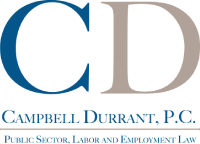On April 29, 2024, the U.S. Equal Employment Opportunity Commission (EEOC) published new Guidance to prevent harassment in the workplace. This new Guidance replaced all past guidance from the EEOC and serves as a comprehensive resource for EEOC-enforced workplace harassment law. There are several major changes including the addition of protected characteristics such as sexual orientation, gender identity, and pregnancy, childbirth, or other related conditions as well as guidance on the use of the internet and technology in workplace harassment. The guidance also clearly outlines when workplace harassment is in violation of the law.
For workplace harassment to violate the law, the harassment must be based on an employee’s legally protected characteristic. In the new EEOC Guidance, protected characteristics include race, color, national origin, religion, sex (including sexual orientation, gender identity, and pregnancy), age, disability, and genetic information. Below are some of the Guidance’s key points on these protected characteristics with the biggest changes seen in harassment based on sex.
• Race – in addition to harassment specifically directed at an individual’s race, this also includes harassment based on traits linked to an individual’s race such as name, cultural dress, accent, physical characteristics, and appearance standards (e.g. hair texture or style).
• Color – related to race and national origin, but is more so directed toward an individual’s skin tone or complexion (e.g. harassing Black employees with darker complexions, but not with light complexion).
• National Origin – harassment related to an individual or ancestors’ place of origin and includes harassment specifically directed at an individual’s national origin as well as harassment based on traits linked to an individual’s national origin such as physical characteristics, ancestry, cultural characteristics (e.g. attire or diet), and accent or lack of fluency in English.
• Religion – includes atheism or lack of a religious belief and also encompasses explicitly or implicitly coercing employees to engage in religious practices at work.
• Sex
o Harassing Conduct of a Sexualized Nature or Based on Sex – includes not only unwanted sexual conduct, but also non-sexual conduct based on sex such as sexist comments or bullying directed toward one sex only.
• Pregnancy, Childbirth, or Related Medical Conditions – not only includes harassment directly related to pregnancy or childbirth (e.g. morning sickness), but also harassment related to lactation, using or not using contraception, and deciding to have, or not to have, an abortion.
• Sexual Orientation and Gender Identity – not only includes harassment specifically directed at an individual’s sexual orientation or gender identity, but also outing (disclosure of an individual’s sexual orientation or gender identity without permission), harassment because an individual does not present in a manner stereotypical to that person’s sex, misgendering (repeated and intentional use of a name or pronoun inconsistent with the individual’s known gender identity), or denial of access to a bathroom or other facility consistent with the individual’s gender identity.
• Age (over 40) – harassment based on either negative perceptions or other stereotypes of older works even if not motivated by negative intentions (e.g. pressuring older employee to transfer to a job that is less technology-focused because of the perception that older workers are not suited for such work or encouraging an older employee to retire).
• Disability – not only includes harassment specifically directed toward either a physical or mental disability, but also encompasses harassment related to an individual’s request for or receival of an accommodation, harassment because an individual is regarded as having an impairment even if they do not have an actual disability, and harassment directed toward the disability of a person with whom an individual is associated (e.g. a family member with a disability).
• Genetic Information – harassment based on an individual’s, or an individual’s family member’s, genetic test or family medical history.
Harassment still occurs despite a mistaken belief of the individual’s protected characteristic. For example, the harassment of a Hispanic person because the harasser believes the individual is Pakistani is national origin-based harassment. Additionally, harassment related to a protected characteristic includes harassment due to association with someone in a protected class. For example, harassment of a White employee because their husband is Black. Lastly, harassment based on a protected characteristic is still covered even if the harasser is a member of the same protected class.
While not a change to past guidance, it is important to note that in addition to the harassment being based on an employee’s legally protected characteristic, for harassment to violate the law, the harassment must either 1) involve a change in the victim’s employment or 2) create a “hostile work environment.” Examples of a change in the victim’s employment include being fired, demoted, denied a promotion or transfer, or reassigned. Even where there is not a change in the victim’s employment as a result of the harassment, the harassment might create a “hostile work environment.” A “hostile work environment” exists when harassment is so severe or pervasive that a reasonable person in the employee’s position would find the situation to be abusive. A key point to keep in mind is that the harassment does not need to be both severe and frequent. A single, severe incident such as touching another’s intimate body part or using a racial epithet can be enough to create a “hostile work environment.” And on the other side, continuous, but less severe harassment over an extended period can also create a “hostile work environment.”
Another change in the EEOC Guidance is the inclusion of harassment using technology. Some technology-based harassment can take place in the workplace by using an employer’s email system or other communication technology. The Guidance does not strictly limit this harassment to the use of workplace technology. While an employer is generally not responsible for conduct that occurs in a non-work-related context, an employer may still be liable if the out-of-work conduct has consequences in the workplace and contributes to a “hostile work environment.” This can even include the use of private phones, computers, or social media accounts. For example, a social media post using a racial epithet directed toward another employee can constitute workplace harassment if the harassed employee either directly sees the post or learns of it through discussion at work. This could also include the distribution of a real or computer-generated intimate image of an employee without their consent and even harassing memes directed toward a protected characteristic of an employee.
To prevent workplace harassment, the EEOC Guidance strongly encourages employers to: 1) have a clear, easy-to understand anti-harassment policy; 2) have a safe and effective procedure that employees can use to report harassment, including more than one option for reporting; 3) provide recurring training to all employees, including supervisors and managers; and 4) take steps to ensure the anti-harassment policy is being followed and the complaint process is working.
* Jeffrey M. Chmay contributed to the writing of this article.
Takeaways:
• The EEOC has issued a new, comprehensive Guidance document on the enforcement of the anti-harassment provisions of federal antidiscrimination laws.
• The Guidance addresses standards for areas of harassment such as harassment based on gender identity, national origin, and other characteristics protected under federal law, and gives examples of types of conduct that constitutes actionable harassment.
• The Guidance reinforces the need for employers to have a clear, easy-to-understand anti-harassment policy with an effective reporting and enforcement procedure, and that employers must provide recurring training of the workforce on the employer’s policy.
Bottom Line:
Employers should make sure that their anti-harassment policy complies with the EEOC’s Guidance and update any out-of-date policy language. Employers must also provide training to their employees on their anti-harassment policy to make it effective. Campbell Durrant attorneys are available to assist you with review of your anti-harassment policy and training for your workforce.





